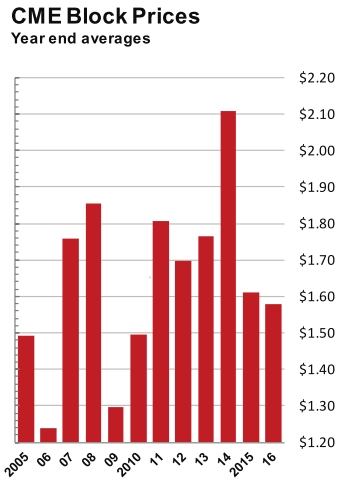Washington—The US Commodity Futures Trading Commission (CFTC) this week published a reproposal of rules concerning speculative position limits for derivatives, but the reproposal doesn’t include Class III milk futures.

As part of the so-called Dodd-Frank Act of 2010, Congress amended the Commodity Exchange Act’s (CEA) position limits provision, which since 1936 has authorized the CFTC to impose limits on speculative positions to prevent the harms caused by excessive speculation.
Pursuant to these amendments, the CFTC adopted a position limits rule in 2011. The agency was then sued over part of the rule, and a federal district court ruled that the agency had to rewrite part of the rule.
Under the original final rule, the CFTC established a position limits regime for 28 exempt and agricultural commodity futures and options contracts, including Class III milk futures, and the physical commodity swaps that are economically equivalent to such contracts.
The CFTC’s reproposal does not address three cash-settled contracts, including Class III milk as well as feeder cattle and lean hogs which, under a December 2013 position limits proposal, were included in the list of core ferenced futures contracts.
Commenters
expressed the view that proposed limits based on an open interest
formula would result in limit levels for dairy contracts that are too
low and would restrict hedging use by limiting liquidity.
The
CFTC responds that it is deferring the imposition of position limits on
the Class III milk, feeder cattle and lean hogs contracts. Commenters
had raised concerns with these cash-settled contracts and how they fit
within the federal position limits regime.
While
many of these concerns were raised in the context of the dairy
industry, the CFTC said they apply to all three cash-settled core
ferenced futures contracts. Concerns raised include: how to apply spot
month limits in a contract that is cash-settled; the “five-day rule” for
bona fide hedging; and the length of the spot month period.
Commenters
contended that the CFTC’s rationale in its December 2013 position
limits proposal focused on concerns with physical-delivery contracts,
which the commenters believe do not apply to cash-settled core
referenced futures contracts because there is no physical delivery
process and because the contracts settle to government-regulated price
series (through USDA).
Commenters
were concerned that the CFTC’s “one-size-fits-all” approach
discriminates against participants in dairy and livestock because the
spot-month limit is effectively smaller compared to the separate
spot-month limits for physical-delivery and cash-settled contracts in
other commodities.
Several
commenters suggested limit levels that do not follow the proposed
formulae for determining levels for both spot and non-spotmonth limits
due to the unique aspects of cash-settled core referenced futures
contracts, including the relatively large cash market and trading
strategies not found in other core referenced futures markets.
The
CFTC, as part of the phased approach to implementing position limits on
all physical commodity derivative contracts, has decided to defer
action so that it may, at a later date: clarify the application of
limits to cash-settled core referenced futures contracts; and consider
further which method to use to determine a level for a spotmonth limit
for a cash-settled core referenced futures contract.
The
CFTC noted that its 2013 position limits proposal discussed spot-month
limits primarily in the context of protecting the price discovery
process by preventing corners and squeezes.